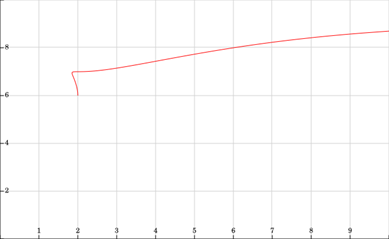
Concept explainers
(a)
To find: The position of the particle at time
(a)
Answer to Problem 43E
The required position
Explanation of Solution
Given Data:
The given equation for the velocity is
Calculation:
Consider the velocity vector is
Then, from the above explanation.
Substitute the position of the particle as,
Thus, the position particle is,
(b)
To find: The distance that the particle travels from
(b)
Answer to Problem 43E
The distance that the particle travels is shown in Figure 1
Explanation of Solution
Consider the equation,
Consider the position of the particle at
The required position of the particle is,
Thus, the required position vector is,
The graph to show the distance travelled by the particle is shown in Figure 1

Figure 1
Chapter 11 Solutions
Calculus 2012 Student Edition (by Finney/Demana/Waits/Kennedy)
Additional Math Textbook Solutions
University Calculus: Early Transcendentals (4th Edition)
Thinking Mathematically (6th Edition)
Elementary Statistics
Algebra and Trigonometry (6th Edition)
Elementary Statistics (13th Edition)
- Find a unit normal vector to the surface f(x, y, z) = 0 at the point P(-3,4, -32) for the function f(x, y, z) = In -4x -5y- Please write your answer as a vector (a, b, c) with a negative z component, and show your answer accurate to 4 decimal placesarrow_forwardFind the differential of the function f(x, y) = 2x² - 2xy – 5y² at the point (-6, -5) using Ax = 0.3 and Ay = 0.05. dz = Now find Az and compare it to your answer above Ax= Hint: If entering a decimal, round to at least 5 placesarrow_forwardFind the differential of the function f(x, y) = −8x√y at the point (1,3) using Ax = 0.25 and Ay = -0.15. dz Now find Az and compare it to your answer above Az = Hint: If entering a decimal, round to at least 5 placesarrow_forward
- please dont use chat gpt i need to underarrow_forwardChris Lynch plans to invest $200 into a money market account. Find the interest rate that is needed for the money to grow to $1,800 in 12 years if the interest is compounded quarterly. The rate is %. (Round to the nearest percent.)arrow_forwardFind the interest earned on $10,000 invested for 6 years at 6% interest compounded as follows. a. Annually b. Semiannually (twice a year) c. Quarterly d. Monthly e. Continuouslyarrow_forward
- 6.9x y= 100-x a. Find the cost of removing each percent of pollutants: 50%; 70%; 80%; 90%; 95%; 98%; 99%. 50% y = 70% y = 80% y = 90% YF 95% y = 98% y= 99% V =arrow_forwardThe cost per ton, y, to build an oil tanker of x thousand deadweight tons was approximated by 215,000 C(x)= x+485 C(25) C(100) C(300) =1 C(50) = = C(200) = C(400) =arrow_forwardi need help pleasearrow_forward
 Calculus: Early TranscendentalsCalculusISBN:9781285741550Author:James StewartPublisher:Cengage Learning
Calculus: Early TranscendentalsCalculusISBN:9781285741550Author:James StewartPublisher:Cengage Learning Thomas' Calculus (14th Edition)CalculusISBN:9780134438986Author:Joel R. Hass, Christopher E. Heil, Maurice D. WeirPublisher:PEARSON
Thomas' Calculus (14th Edition)CalculusISBN:9780134438986Author:Joel R. Hass, Christopher E. Heil, Maurice D. WeirPublisher:PEARSON Calculus: Early Transcendentals (3rd Edition)CalculusISBN:9780134763644Author:William L. Briggs, Lyle Cochran, Bernard Gillett, Eric SchulzPublisher:PEARSON
Calculus: Early Transcendentals (3rd Edition)CalculusISBN:9780134763644Author:William L. Briggs, Lyle Cochran, Bernard Gillett, Eric SchulzPublisher:PEARSON Calculus: Early TranscendentalsCalculusISBN:9781319050740Author:Jon Rogawski, Colin Adams, Robert FranzosaPublisher:W. H. Freeman
Calculus: Early TranscendentalsCalculusISBN:9781319050740Author:Jon Rogawski, Colin Adams, Robert FranzosaPublisher:W. H. Freeman
 Calculus: Early Transcendental FunctionsCalculusISBN:9781337552516Author:Ron Larson, Bruce H. EdwardsPublisher:Cengage Learning
Calculus: Early Transcendental FunctionsCalculusISBN:9781337552516Author:Ron Larson, Bruce H. EdwardsPublisher:Cengage Learning





